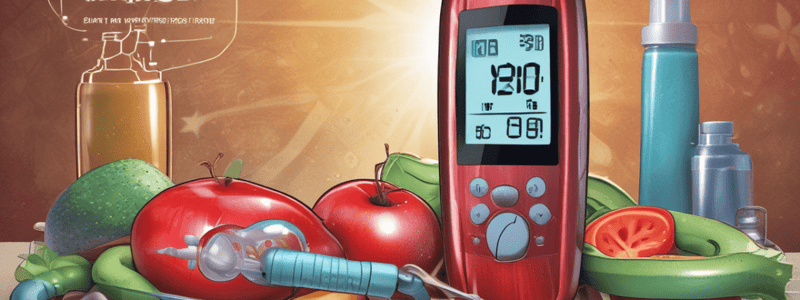Podcast
Questions and Answers
What was the primary focus of the initial attempt to teach patients to adjust their insulin doses?
What was the primary focus of the initial attempt to teach patients to adjust their insulin doses?
- To educate patients on the importance of regular exercise
- To teach patients to evaluate their treatment by comparing their blood glucose values against a visual target range (correct)
- To instruct patients on how to count carbohydrates in their meals
- To provide patients with a fixed insulin dosage for their entire lives
What was a common issue with the initial method of adjusting insulin doses based on blood glucose values?
What was a common issue with the initial method of adjusting insulin doses based on blood glucose values?
- It was too time-consuming for patients
- It resulted in inconveniently timed hypoglycemia due to exercise and dietary deviations (correct)
- It was too complex for patients to understand
- It was only effective for patients with type 1 diabetes
What is an essential aspect of insulin dosing, according to evidence-based advice?
What is an essential aspect of insulin dosing, according to evidence-based advice?
- Administering a fixed dose of insulin before every meal
- Varying insulin doses based on carbohydrate intake and other factors (correct)
- Injecting insulin only once a day
- Adjusting insulin doses based solely on blood glucose values
Why is the old advice for a fixed dose of insulin deemed unacceptable?
Why is the old advice for a fixed dose of insulin deemed unacceptable?
What is a useful suggestion for managing insulin doses during large meals?
What is a useful suggestion for managing insulin doses during large meals?
What is the ultimate goal of the diabetes management program discussed in the chapter?
What is the ultimate goal of the diabetes management program discussed in the chapter?
What is the primary consequence of not considering caloric drift in patients?
What is the primary consequence of not considering caloric drift in patients?
What is the primary purpose of using a 10% correction in insulin dosing?
What is the primary purpose of using a 10% correction in insulin dosing?
What is the primary factor affecting the Carbohydrate Ratio?
What is the primary factor affecting the Carbohydrate Ratio?
What is the key factor in successfully matching insulin dose to the likely blood glucose outcome of a meal?
What is the key factor in successfully matching insulin dose to the likely blood glucose outcome of a meal?
What is the recommended Carbohydrate Ratio for patients on intensive therapy?
What is the recommended Carbohydrate Ratio for patients on intensive therapy?
What is the main difference between fixed-dose insulin therapy (FIT) and multiple daily injections of insulin?
What is the main difference between fixed-dose insulin therapy (FIT) and multiple daily injections of insulin?
What percentage of daily insulin dose comes from the Carbohydrate Ratio?
What percentage of daily insulin dose comes from the Carbohydrate Ratio?
What is the consequence of not refining patient education on the implications of food choices on disease factors?
What is the consequence of not refining patient education on the implications of food choices on disease factors?
Why do girls tend to have a higher Carbohydrate Ratio than boys?
Why do girls tend to have a higher Carbohydrate Ratio than boys?
What is the primary advantage of using carbohydrate ratio and fixed-dose insulin therapy (FIT) over rule-of-thumb approaches?
What is the primary advantage of using carbohydrate ratio and fixed-dose insulin therapy (FIT) over rule-of-thumb approaches?
What is the phenomenon seen in patients with type 1 DM and type 2 DM on insulin, involving unintended increases in HbA1c and total daily insulin?
What is the phenomenon seen in patients with type 1 DM and type 2 DM on insulin, involving unintended increases in HbA1c and total daily insulin?
What is the hypothesis that suggests a small genetically or epigenetically determined increase in fatness due to a minute and chronic excess of energy intake over expenditure?
What is the hypothesis that suggests a small genetically or epigenetically determined increase in fatness due to a minute and chronic excess of energy intake over expenditure?
What is the alternative hypothesis to the drifty hypothesis?
What is the alternative hypothesis to the drifty hypothesis?
What is the term used to describe a mismatch between energy intake and energy expenditure, resulting in a small but significant increase in weight and an increase in the levels of circulating insulin?
What is the term used to describe a mismatch between energy intake and energy expenditure, resulting in a small but significant increase in weight and an increase in the levels of circulating insulin?
Why do individuals with type 2 DM tend to have a higher caloric requirement (CR) compared to those of the same body weight with type 1 DM?
Why do individuals with type 2 DM tend to have a higher caloric requirement (CR) compared to those of the same body weight with type 1 DM?
What is the strategy that allows patients to match a unit of insulin to a certain amount of carbohydrates?
What is the strategy that allows patients to match a unit of insulin to a certain amount of carbohydrates?
Flashcards are hidden until you start studying




